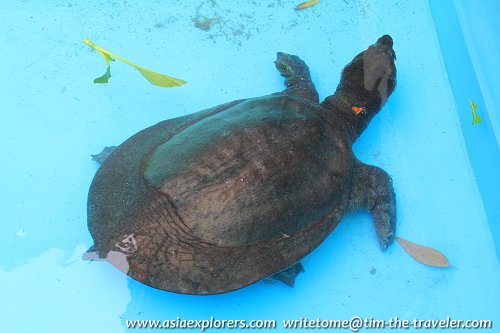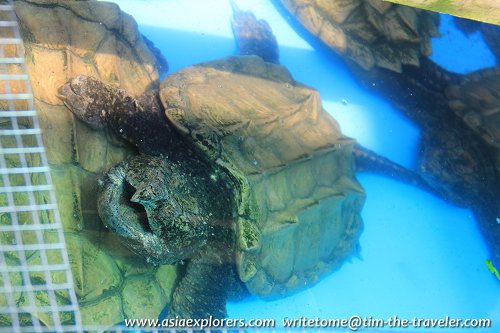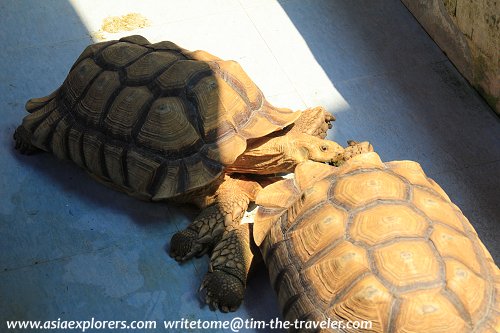The Live Turtle & Tortoise Museum is said to be the largest museum of its kind in the world. It is located within the Chinese Garden in Singapore. The museum is home to 3,456 tortoises and turtles, including over a thousand live specimens. Visitors to the museum will be able to get to know the many different types of turtles and tortoises which are kept in tanks and in outdoor partitions. They will soon realise, however, that the over three thousand tortoises and turtles includes statues, dolls and stuffed toys which are also displayed within the museum.
The following are some of the turtles and tortoises found at the Live Turtle & Tortoise Museum. I hope these photos will make you interested to pay a visit to the museum and watch the live specimens yourself. The Asian Soft Shelled Turtle Trionya Cartilaginous is found in river beds throughout Asia. It feeds on insect larvae, crabs, fish and some times fruits and seeds. It is a popular tradition among the Chinese to buy these turtles for release, in order to obtain good merit. This turtle is agile and aggressive. It will try to bite anybody attempting to hold it. The turtle's soft shell helps it in floatation.
 Asian Soft Shelled Turtle (11 July 2011)
Asian Soft Shelled Turtle (11 July 2011)
The Alligator Snapping Turtle (Macroclemys temminckii) comes from the southern states of the United States, from Georgia to Florida as well as Texas, Iowa, southern Illinois and Indiana. A full grown adult can reach a weight of 99.5 kg (220 lb), making it one of the biggest freshwater turtles in the world.
 Alligator Snapping Turtle (11 July 2011)
Alligator Snapping Turtle (11 July 2011)
The African Tortoise (Geochelone Sulcata) is the largest continental land tortoise. It has been measured to reach a length of 83 cm (over 2.5 feet) and weigh as much as 105 kg (240 lb). The female lay between two to twelve eggs which they keep buried underground for as much as eight months.
 African Tortoise (11 July 2011)
African Tortoise (11 July 2011)
 African Tortoise (11 July 2011)
African Tortoise (11 July 2011)
The Burmese Peacock Turtle (Genus Morenia) has a domed shell. It has two yellow streaks across the side of its head. This turtle is now an endangered species. Its habitat is increasingly being threatened by development and pollution. The turtle is also being illegally poached for Chinese medicine.
 Burmese Peacock Turtle (11 July 2011)
Burmese Peacock Turtle (11 July 2011)
The Yellow Spotted Amazon River Turtle comes from South American countries such as Colombia, Brazil and Bolivia. It has a yellow spotted head with a dark brown carapace. This turtle enjoys having water running on its back.
 Yellow Spotted Amazon River Turtle (11 July 2011)
Yellow Spotted Amazon River Turtle (11 July 2011)
The Travancore Tortoise (Indotestudo Forstenii) comes from India. It is usually active at dawn. This tortoise is quite aggressive and territorial. it will often fight other creatures to protect its territory. The tortoise has an elongated, domed carapace with serrated rear scutes.
 Travancore Tortoise (11 July 2011)
Travancore Tortoise (11 July 2011)
The Pig Nose Turtle, found in rivers in Papua New Guinea and the Northern Territory of Australia, has a snout that allows it to hunt for food, which includes aquatic plants, ripe fruits, water insects and small fish.
 Pig Nose Tortoise (11 July 2011)
Pig Nose Tortoise (11 July 2011)
List of the Parks in Singapore; Discover Singapore
 Copyright © 2003-2025 Timothy Tye. All Rights Reserved.
Copyright © 2003-2025 Timothy Tye. All Rights Reserved.
Copyright © 2003-2025 Timothy Tye. All Rights Reserved.

 Go Back
Go Back